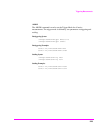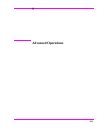
236
S:\agilent\8920\8920b\PRGGUIDE\BOOK\CHAPTERS\advoper.fb
Chapter 5, Advanced Operations
Increasing Measurement Throughput
3. Frequency Counter Gate Time
The frequency counter’s gate time specifies how long the RF or AF frequency
counter samples the signal before displaying the measured result. Short gate times
measure instantaneous frequency and long gate times measure average frequency.
The longer the gate time, the longer the measurement cycle. The proper gate time
is determined by the measurement requirements. Use the following commands to
set gate times:
For AF frequency measurements, set the AF Analyzer’s gate time with the
AF Cnt Gate field, using the following command:
:AFAN:GTIM <value> MS
For RF frequency measurements, set the RF Analyzer’s gate time with the
RF Cnt Gate field, using the following command:
:RFAN:GTIM <value> MS
4. Number of Active Measurements
The Test Set is capable of making many measurements simultaneously.
Measurements are either in the active state (ON) or in the inactive state (OFF).
When the Test Set receives a trigger event, all active measurements are triggered.
A measurement cycle is complete when all active measurements have obtained a
valid measurement result. To decrease the measurement cycle time, all unused
measurements should be set to the inactive state (turned OFF). Turning OFF
unused measurements will have the greatest impact on reading repetition rate. Use
the STATe command to turn OFF all unneeded measurements on the displayed
screen.
Optimizing Measurement Setup Time
Measurement setup time is defined as the time required to configure an individual
instrument within the Test Set to make a measurement.
In general there are two methodologies which can be used to setup individual
instruments in the Test Set:
1. Set up every field every time a measurement is made.,
2. Define a base instrument state and then modify it as needed for each measurement
(always returning to the base state after finishing the measurement).
Defining a base instrument state requires fewer GPIB transactions to set up an
instrument (in the majority of cases) which in turn reduces measurement setup
time.


















